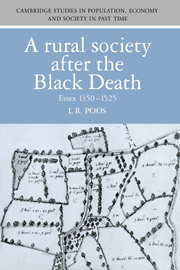Book contents
- Frontmatter
- Contents
- List of figures
- List of tables
- Preface
- Abbreviations
- Part I Reflections on a transitional era
- Part II ‘Country-dwellers, common folk and craftsmen’
- Part III ‘The total sum of all persons’
- Part IV ‘While it is so forward between us’
- Part V ‘She came that day seeking service’
- Part VI ‘Beware of such holy men’
- Part VII Synthesis
- Bibliography
- Index
- Cambridge Studies in Population, Economy and Society in Past Time 18
Part II - ‘Country-dwellers, common folk and craftsmen’
Published online by Cambridge University Press: 14 September 2009
- Frontmatter
- Contents
- List of figures
- List of tables
- Preface
- Abbreviations
- Part I Reflections on a transitional era
- Part II ‘Country-dwellers, common folk and craftsmen’
- Part III ‘The total sum of all persons’
- Part IV ‘While it is so forward between us’
- Part V ‘She came that day seeking service’
- Part VI ‘Beware of such holy men’
- Part VII Synthesis
- Bibliography
- Index
- Cambridge Studies in Population, Economy and Society in Past Time 18
Summary
The central and northern district of Essex during the later middle ages contained a quite distinctive configuration of social, economic and occupational groups, and of local economic and settlement geography. By the early fourteenth century, at least half of local households were smallholders or landless, drawn into wage labour or artisanal by-employment. Unlike what may have happened in other regions of England, this situation did not change appreciably after the Black Death of 1348–9 extinguished one-third or more of the district's residents. To the contrary, marked disparity of landholding and occupation continued to characterise the area well beyond the close of the medieval period. Hence much of the following chapters will address the factors contributing to this situation, their ultimate implications for local social structure, and the differences in experiences that different groups within the local population underwent.
The district was very densely populated during the period. Besides helping to account for economic disparity, two further corollaries of population density were market dependence and occupational complexity, both probably stemming from local circumstances rather than the influence of external urban centres such as London. In fact, the economic typology of local communities did not make for sharp demarcations between ‘urban’ and ‘rural’. Craftsmen and retailers permeated the smallest villages and the smallest satellite hamlets of larger settlements.
As in most of England, the post-Black Death period witnessed shifts in local agriculture and land use as animals gained in relative importance to grain.
- Type
- Chapter
- Information
- A Rural Society after the Black DeathEssex 1350–1525, pp. 9 - 10Publisher: Cambridge University PressPrint publication year: 1991



